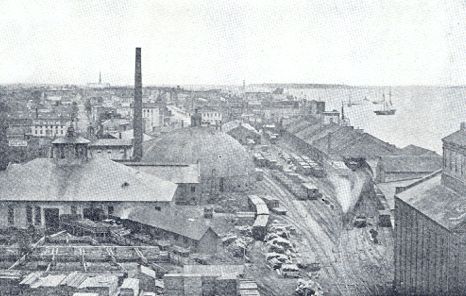- Details
- Hits: 2494
Location: Third Street Freight Yards (MC), Detroit, MI
 The original Michigan Central railroad Detroit freight yards were located at the foot of the Detroit River near Third street and the MC's passenger station.
The original Michigan Central railroad Detroit freight yards were located at the foot of the Detroit River near Third street and the MC's passenger station.
Notes
The yard complex had the following facilities and track capacity:
- Slip dock - 259 cars
- Team tracks - 165 cars
- House tracks - 255 (freight house)
- Crane tracks - 39 cars
- Edgar's 8 tracks - 44 cars
This complex also had passenger facilities, grain elevators, freight houses, ship transloading facilities and a domed roundhouse at one time or another.
Photo info: Top, a 1868 photograph of the 3rd Street Tard and terminal in Detroit. The passenger station in this facility was used in various forms by the Michigan Central from 1847 until 1912, when it burned and operations were transferred to the new MCRR Station at 17th Street. The freight house and docks were used for many years thereafter. The round dome structure is the locomotive roundhouse. The large building on the right along the river is the freight station, which loaded freight cars inside and had docks on the river side for transloading ships. The smaller building at the right rear of the roundhouse was also a freight terminal and the passenger station was behind that to the right. [HWC]
Time Line
1882. The MC freight department will take charge of the freight sheds at the foot of Fourth Street, and heretofore known as the Grand Trunk freight houses. The sheds will be used for the handling of freight consigned to city parties, which department will be under the charge of the local freight agent for the MC, the Detroit & Bay City and the Flint & Pere Marquette. The old "city side" sheds will be used for the reception of car lots of manufactured goods and of raw materials. [DFP-1882-1006]
1935. The outbound loading platforms at this terminal had color-light signals which governed engine and train movements on the southerly five tracks for the outbound loading platforms. The west entrance is governed by two signals and is protected by four derails; one signal and two derails for tracks 1,2 and 3, and one signal and two derails for tracks 4 and 5. Movements in either direction on tracks 1, 2, and 3 are governed by signals on the south side of track No. 1, one at each of the three bridges. Movements in either direction on tracks 4 and 5 are governed by signals between tracks, one over each of the two bridges. The signal aspects and indications are: Red - stop and stay. Yellow - proceed at low speed. The normal aspect of signals is red and derails are normally in the derailing positions. To clear signals for either group of tracks, the derails must be changed to the non-derailing position, which operation will clear the signals automatically. The derails cannot be changed to the non-derailing position unless the bridges are fully raised, which condition will be indicated by the vertical positoin of the arm of the indicator at the switch stand, which controls the derails. If any bridge is lowered while the derails are in the non-derailing position, a bell located at the east end of the platforms will ring until the bridge is raised or the derail is restored to the derailing position. [MC Detroit Terminal Timetable No. 76]
Bibliography
The following sources are utilized in this website. [SOURCE-YEAR-MMDD-PG]:
- [AAB| = All Aboard!, by Willis Dunbar, Eerdmans Publishing, Grand Rapids ©1969.
- [AAN] = Alpena Argus newspaper.
- [AARQJ] = American Association of Railroads Quiz Jr. pamphlet. © 1956
- [AATHA] = Ann Arbor Railroad Technical and Historical Association newsletter "The Double A"
- [AB] = Information provided at Michigan History Conference from Andrew Bailey, Port Huron, MI

